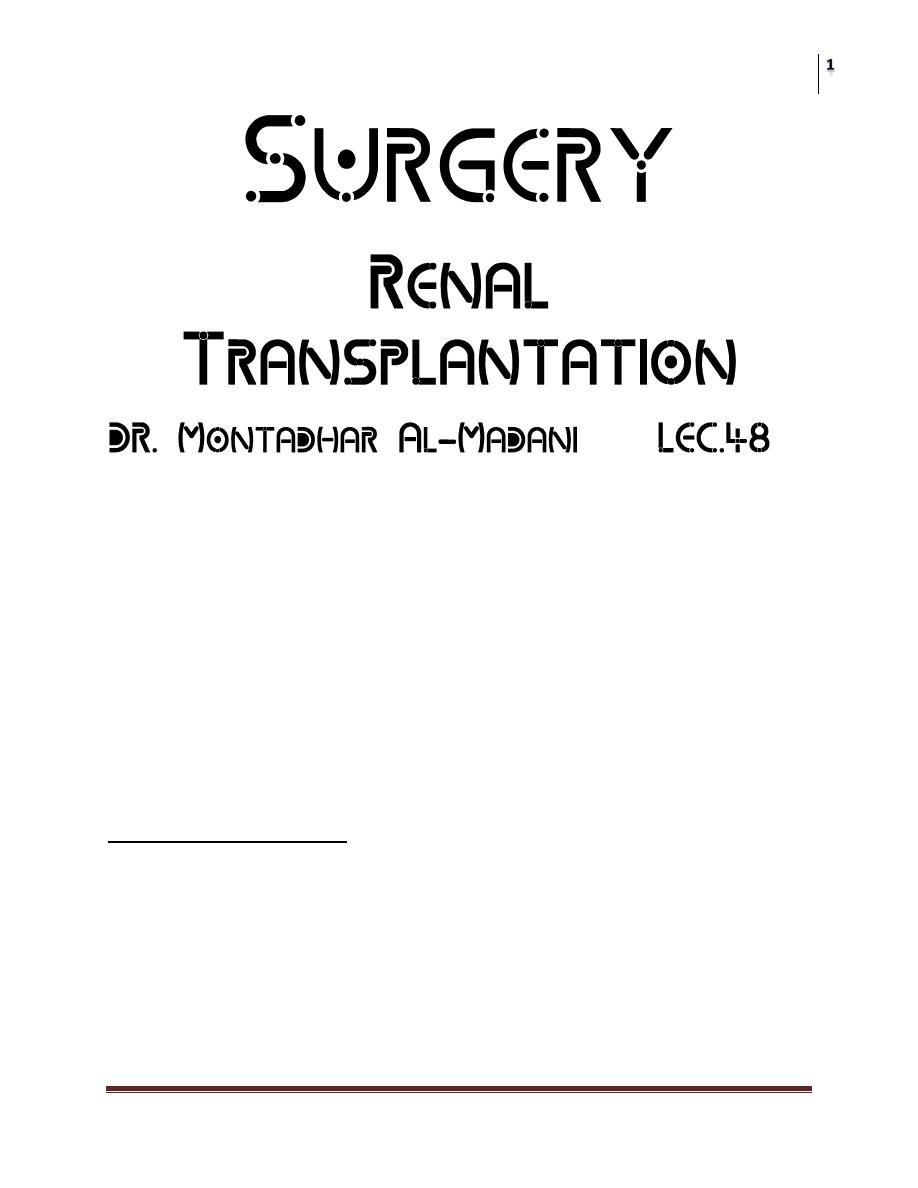
Surgery
Renal Transplantation
Dr. Montadhar Al-Madani
Lec. 48
Indications
The most frequent diagnoses of renal failure leading to transplantation are
• diabetes 23% (the fastest growing);
• All types of glomerulo-nephritis/focal sclerosis 24%; hypertension-
nephrosclerosis 16%; cystic kidney diseases 9%; interstitial/pyelonephritis
5%; urologic diseases 4%; and unknown causes 13%.
• Children < age 18 with renal failure often have congenital urologic
conditions such as obstruction, valves, dysplasia, cystic disease, reflux,
prune-belly syndrome, inborn errors of metabolism (stones), or neurogenic
bladders .
CONTRA INDICATIONS
1-INFECTION
• Bacterial—Active infections are a contraindication to transplantation, which
need to be appropriately treated and resolved.
• Viral—Herpes family DNA viruses such as cytomegalovirus (CMV),
Epstein-Barr Virus (EBV), varicella zoster (VCZ), and herpes simplex
(HSV) can be transmitted with the donor organ or reactivated from a latent
state in the recipient.

Surgery
Renal Transplantation
Dr. Montadhar Al-Madani
Lec. 48
2. MALIGNANT DISEASE
• Active or recently recurrent malignant disease is an absolute
contraindication to renal transplantation. The bulk of evidence suggests that
immunosuppressive therapy facilitates the growth of residual cancers. a
minimum waiting period of 2 years for cancers with a favorable prognosis is
desirable.
3-SYSTEMIC AND METABOLIC DISEASE
• Patients with certain metabolic diseases affecting the kidney such as Fabry’s
disease, hemolytic uremic syndrome, vasculitis, systemic lupus
erythematosus, amyloidosis, etc.
4-CARDIOVASCULAR STATUS
• Cardiovascular disease represents the leading cause of death after kidney
transplantation and is ubiquitous among renal failure patients, especially
diabetics and those over age 50.
• Potential recipients should be thoroughly screened, and have symptomatic
lesions corrected prior to transplant.
5-GASTROINTESTINAL DISEASE
• Patients with ESRD often have a history of gastrointestinal (GI) problems
such as peptic ulcer disease, gastroesophageal reflux, cholecystitis,
pancreatitis, inflammatory bowel disease, diverticulosis, chronic diarrhea or
constipation, or hemorrhoids. If present, these should be evaluated and
resolved prior to transplant.
MODIFIABLE RISK FACTORS
• Obesity; Weight reduction to under the morbidly obese range is desirable,
and may require bariatric surgery in extreme circumstances.
• Smoking: Tobacco smoking is particularly deleterious for transplant
recipients, and patients need to stop prior to transplantation.

Surgery
Renal Transplantation
Dr. Montadhar Al-Madani
Lec. 48
GENITOURINARY TRACT EVALUATION
• Potential recipients without a history of urologic symptoms or prior
interventions do not need an extensive evaluation.
• Upper tract ultrasound and urine cultures usually suffice; some recommend
voided cytology.
• An age appropriate screening PSA in males.
• Patients with a history of urologic symptoms (especially hematuria,
infections, stones, and incontinence), prior interventions, or a neurogenic
bladder should have a full urologic evaluation .
indications for nephrectomies are rare, and include
• heavy proteinuria (>10 g/day),
• intractable hypertension (4–5 drugs),
• and persistent hematuria.
• Kidneys with chronic hydronephrosis, high-grade reflux, stones, abscesses,
filling defects, enhancing masses, complex or very large cysts, etc. that may
lead to persistent infections or harbor potential cancers should be removed
prior to transplant. In addition, very large polycystic kidneys may need
removal for relief of symptoms or size considerations.
SELECTION OF DONORS
• The basic criteria for a renal donor are an absence of renal disease, an
absence of active infection, and an absence of transmissible diseases.
• Types:
• Living Donor (related, un related).
• Deceased Donor
• The declaration of brain death is the responsibility of the potential deceased
organ donor's physician.
Standard Evaluation of the Potential Live Donor
History: Focus on relation to renal disease Hypertension, diabetes, family history,
use of NSAIDs, other chronic drugs, environmental exposure (heavy metals),
chronic UTI, stones, prior surgery, prior cardiovascular or pulmonary events (TB),
begin to explore desire to donate.

Surgery
Renal Transplantation
Dr. Montadhar Al-Madani
Lec. 48
Physical Exam: Focus on relation to renal disease Blood pressure, weight/height
(BMI), lymph nodes, joints, breast, prostate cardiovascular disease assessment.
Laboratory Testing:
• Urinalysis and culture, electrolytes, BUN creatinine, calcium, phosphorus,
magnesium, liver panel, fasting blood glucose, and lipid profile CBC with
platelets, coagulation screen 24-hr urine, creatinine clearance and protein
excretion or GFR measurement (iothalamate clearance).
• Remote stone history: 24-hr urine calcium, uric acid, oxalate, citrate Viral
serology: hepatitis C; hepatitis B; Epstein Barr virus; cytomegalovirus;
herpes simplex; and RPR (rapid plasmin reagent).
• Electrocardiogram, chest x-ray Females PAP, mammogram-age appropriate
Males PSA (>age 40–50, family history).
Imaging of the Kidneys:
• local availability Computed tomography angiogram
• Magnetic resonance angiogram
• Catheter arteriogram
RECIPIENT OPERATION
• In adults and children who weigh more than 20 kg, a first kidney graft
is usually placed extraperitoneally in the contralateral iliac fossa by way
of a rectus-preserving Gibson incision.
• The renal artery is usually anastomosed to the end of the internal iliac artery
or to the side of the external iliac artery.
• The renal vein is anastomosed to the external iliac vein, usually medial to
the external iliac artery.
• The ureter is drawn through the tunnel, transected, and anastomosed to the
bladder with fine absorbable sutures.
POSTOPERATIVE CARE
• Fluid and Electrolyte Management
• An optional method of fluid management in the recipient of a living
donor kidney transplant is a fixed rate protocol of 125 to 200 mL/hr of
0.45% normal saline in 5% dextrose with an occasional fluid bolus if
hypotension ensues.

Surgery
Renal Transplantation
Dr. Montadhar Al-Madani
Lec. 48
Histocompatibility
• The histocompatibility systems of greatest importance in renal
transplantation are the ABO blood group and the major
histocompatibility complex (MHC).
• The donor and recipient must be ABO compatible because A and B
substances are present on endothelial cells, and most individuals have
antibodies to the red blood cell antigens they lack. A common exception is
the transplantation of ABO blood group A2 kidneys into blood group O and
B recipients, who have low anti-A2 antibody levels.
• The MHC antigens are glycoproteins on the cell membrane. They are
encoded by MHC genes on the short arm of chromosome 6. Autosomal
class I antigens are known as the HLA-A, HLA-B, and HLA-C antigens,
HLA-DR, HLA-DQ, and HLA-DP antigens are class II antigens. HLA-
DR antigens are detected by tissue typing B lymphocytes. Testing for
HLA-DQ and HLA-DP antigens is not routinely done.
Cross-matching
• Preformed circulating anti-HLA antibodies against the specific phenotype of
the donor will lead to acute (if not hyperacute) rejection.
• Such antibodies (usually IgG) are detected by cross-matching the sera of the
recipient with lymphocytes of the donor and adding complement. Such
complement-dependent cytotoxicity (CDC) will kill the donor cells and is
indicative of deleterious clinical outcome.
• positive complement-dependent T-cell lymphocytotoxicity crossmatch is
considered to be a contraindication to renal transplantation.
Classification of Rejection
•
Hyperacute rejection
occurs immediately after renal revascularization.
It is an irreversible process mediated by preformed circulating cytotoxic
antibodies .It is very rare when the microlymphocytotoxicity crossmatch
between recipient serum and donor lymphocytes is negative.

Surgery
Renal Transplantation
Dr. Montadhar Al-Madani
Lec. 48
•
Accelerated rejection
is mediated by humoral and cellular components
of the immune response. It occurs within days to weeks and often does not
respond to antirejection therapy.
•
Acute rejection
can occur any time after transplantation. The
symptoms of acute kidney transplant rejection are those of “the flu,”
accompanied by pain over an enlarged kidney graft, hypertension,
decreased urinary output, fluid retention, increased serum creatinine
levels, radioisotope renography indicating decreased renal blood flow,
glomerular filtration, and tubular function.
•
Chronic rejection
is characterized by a gradual decline in renal
function associated with interstitial fibrosis, vascular changes, and minimal
mononuclear cell infiltration.
IMMUNOSUPPRESSION
• The goal in transplantation is to develop methods that permit a recipient to
keep a transplanted organ in a state of “tolerance”
• Immunosuppressive agents can be used in one of three ways: (1) high dose
or induction therapy to prevent a primary immune response immediately
after transplantation, (2) low dose or maintenance therapy initiated once the
graft function has stabilized, or (3) additional high dose therapy to treat
acute rejection.
CHEMICAL IMMUNOSUPPRESSION
1-Corticosteroids:
2-Antiproliferative drugs:
a. Azathioprine b.Mycophenolate mofetil
c. Cyclophosphamide d. Leflunomide
3. Antilymphocytic drugs:

Surgery
Renal Transplantation
Dr. Montadhar Al-Madani
Lec. 48
TREATMENT OF REJECTION
• Highdose IV steroid pulses of 5–7 mg/kg/day for 3 days will reverse about
85%. Some clinicians also prefer to add a 10– 14 day recycle of oral
prednisone at 2 mg/kg tapered to baseline. If rejections are unresponsive to
steroids or histology confirms vascular changes, a depleting antibody such as
thymoglobulin is given at 7–8 mg/kg over a week.
Complications of Kidney Transplantation
• Surgical
• The majority of significant surgical problems posttransplant are either
vascular or urologic. They include renal artery thrombosis, disruption,
stenosis, or mycotic aneurysm; renal vein thrombosis or disruption; urinary
fistula or ureteral stenosis; lymphocele or hematoma; scrotal hydrocele or
abscess; wound abscess, dehiscence, or hernia Prevention is the best way to
avoid these problems using meticulous surgical and antiseptic techniques,
including the routine use of preoperative broad-spectrum antibiotics.
• MEDICAL COMPLICATIONS
• Bacterial infections
• Viral infections
• Fungal infections
• Posttransplant diabetes
• Posttransplant cancer.
RESULTS OF KIDNEY TRANSPLANTATION
• There have been dramatic improvements in short-term kidney transplant
outcomes since the inception of clinical practice 4 decades ago. For
recipients of LD kidneys 1-year patient and graft survival has increased to
about 97.6% and 95.1%; and for DD recipients 94.5% and 89%.
